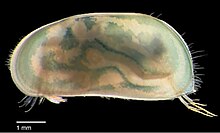
Back سبريسية Arabic Cyprididae CEB Cyprididae French Cyprididae Dutch Cyprididae NB Cyprididae Swedish Cyprididae Turkish Cyprididae WAR 金星介科 Chinese
| Cyprididae | |
|---|---|

| |
| Chlamydotheca unispinosa | |
| Scientific classification | |
| Domain: | Eukaryota |
| Kingdom: | Animalia |
| Phylum: | Arthropoda |
| Class: | Ostracoda |
| Order: | Podocopida |
| Superfamily: | Cypridoidea |
| Family: | Cyprididae Baird, 1845[1] |
| Subfamilies | |
| Synonyms | |
| |
Cyprididae is "the most diverse group of freshwater ostracods".[2] It contains over 1000 species, which represents 50% of the known species of freshwater ostracods (other speciose families include Candonidae, with 25%, and Limnocytheridae, with 10%).[3] Around 60% of genera in the family are endemic to a single zoogeographic region.[3] The family contains 16 subfamilies, and is most diverse in the Afrotropical realm, with over 300 species in 45 genera.[3] Many Cyprididae occur in temporary water bodies and have drought-resistant eggs, mixed/parthenogenetic reproduction and ability to swim. These biological attributes pre-adapt them to form successful radiations in these habitats.[4] Bennelongia is an interesting of the family Cyprididae. It may be the last true descendant of the Mesozoic (and now extinct) lineage of Cypridea, which was a dominant lineage of ostracod in non-marine waters in the Cretaceous.[3]
- ^ Baird, W. 1845: Arrangement of the British Entomostraca, with a List of Species, particularly noticing those which have as yet been discovered within the bounds of the Club. History of the Berwickshire Naturalists' Club, 2 (13) 145-158
- ^ Robin J. Smith; Horst Janz; Ichiro Okubo (2011). "Recent Cyprididae and Ilyocyprididae (Crustacea: Ostracoda) from Lake Biwa, Japan, including a summary of the lake's ostracod fauna" (PDF excerpt). Zootaxa. 2874: 1–37.
- ^ a b c d Koen Martens; Isa Schön; Claude Meisch; David J. Horne (2008). "Global diversity of ostracods (Ostracoda, Crustacea) in freshwater". In Estelle V. Balian; Christian Lévêque; Hendrik Segers; Koen Martens (eds.). Freshwater Animal Diversity Assessment. Developments in Hydrobiology. Springer. doi:10.1007/s10750-007-9245-4. ISBN 978-1-4020-8258-0.
- ^ D. J. Horne; K. Martens (1998). "An assessment of the importance of resting eggs for the evolutionary success of non-marine Ostracoda (Crustacea)". In Luc Brendonck; Luc de Meester; Nelson Hairston (eds.). Evolutionary and ecological aspects of crustacean diapause. Advances in Limnology. Vol. 52. E. Schweizerbart. pp. 549–561. ISBN 978-3-510-47054-9.